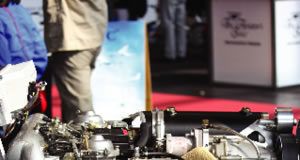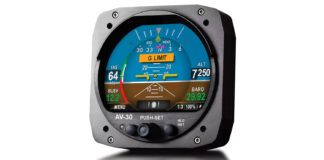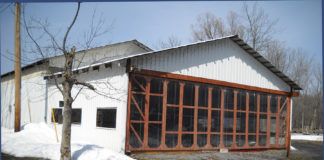All lifting surfaces stall when they exceed some critical angle of attack, but we typically consider stalling of the wing to be the major concern in designing and flying airplanes. While wing stall is important, it is also possible to stall the horizontal tail under some circumstances. Tail stalls are rarer and less well understood than wing stalls.
The horizontal tail has several functions, all of which are vital to providing acceptable flying qualities for the airplane. The tail must stabilize the airplane in pitch. It must also trim out pitching moments caused by the wing, body and CG changes. Finally, the tail must provide control power so the pilot can maneuver the airplane. To perform these functions, the tail must remain unstalled throughout the flight envelope. Stalling it will usually lead to loss of control.

Tail Stall Conditions
There are several situations in which tail stall may be encountered, and some can be extremely dangerous. Tail stalls are most common when the tail is being called upon to generate a large amount of downforce to trim the airplane.
One condition that has proven troublesome is the full-flap, forward-CG configuration. In this situation, the tail must produce a large down load to trim the airplane. If the tail is too small or if it stalls at too small a negative angle of attack, a small change in tail incidence such as the deflection required to trim the airplane in a turn can cause the lower surface of the tail to stall. The airplane will then pitch down, and the pilot will not be able to prevent it from doing so. Tail stalling may also be a problem when trying to push the nose down to recover from high angle of attack flight. This is more typical of modern fighters that fly at extremely high angles of attack.
If the tail stalls in a civilian airplane, it will do so when it is being called upon to generate a large amount of downforce to hold the nose up. In this situation, the lower surface of the tail is the suction side of the surface, and it is the lower side that will stall. Because of this, the critical angle of attack of the tail is negative, and the tail gets closer to stall when the nose of the airplane drops, reducing the angle of attack. This is the reverse of what happens with wing stall, which is caused by the positive (nose up) angle of attack of the airplane exceeding the stall angle of attack of the wing.
A fully developed airplane is unlikely to encounter tail stall in normal operations, because stalling the tail is perilous enough that the airplane will have been modified as necessary during development to eliminate the possibility. During development and flight test, designers and test pilots should be alert for signs of imminent tail stall, particularly when testing with the CG forward and when testing the effect of flaps on the characteristics of the airplane.
Some cues a test pilot should be on the lookout for are running out of up elevator effectiveness, significant buffeting of the tail at angles of attack that are below the normal wing stall angle of attack and any non-commanded nose-down motion of the airplane. All of these could be warnings of a potentially dangerous situation.
If the tail is going to stall, it will do so when the nose is lowered with the airplane in a high tail downforce configuration. Tail stalls can also be precipitated by changing the configuration of the airplane by lowering flaps. This can be tricky for two reasons. First, pilots do not expect stall-related problems when they lower the nose, because lowering the nose is how they are trained to recover from wing stalls. Second, and more important, is that if the tails stalls, the airplane will pitch down and exacerbate the situation. This can be dangerous, because it may not be possible to recover form the ensuing dive without changing the configuration of the airplane.
John Choita, the designer of the Weedhopper ultralight, was killed in a tail stall accident in the Weedhopper Rocket, a later design of his that was quite different from the original Weedhopper. The Rocket had a small tail set relatively close to a highly cambered wing. Unfortunately for Choita, the tail stalled when he lowered the nose on approach on a turbulent day, and he was unable to recover. The few in-flight pictures of the Rocket that survive all show that the airplane had a large amount of up elevator deflection when trimmed in level flight. Although we will never know for sure, it seems likely that the tail was working hard all the time, and could not hold the nose up when the angle of attack got below a critical value.
Flaps and Tail Stall
The lift produced by a deflected flap acts on the aft portion of the airfoil. This generates a nose-down pitching moment. The horizontal tail opposes the nose-down moment of the flaps by producing a downforce on the aft end of the fuselage. Because the moment arm of the tail is much longer than the moment arm of the flaps, the downforce on the tail is smaller than the lift on the flaps, and there is a net gain in total lift on the airplane.
The forward CG limit of an airplane is usually set by the combination of the nose-down pitching moment of the flaps and the control power of the horizontal tail. As the CG moves forward, the tail must produce more downforce to trim the airplane. At some CG location, the elevator hits the stop just as the airplane reaches its stall angle of attack with full flaps. This CG position is the forward limit; if the CG moves forward of this, the elevators will run out of control power before the wing reaches maximum lift.
Usually, the pitching moment produced by the flaps just sets the forward CG limit of the airplane. We must bear in mind that the tail must be able to produce enough force to trim the airplane. It is possible to have a situation where the lower surface of the tail stalls, and the tail loses the ability to produce downforce. There are two times when this can happen, both involving an airplane with flaps down, flying at a relatively low angle of attack as in the pattern or on a long straight-in final approach.

Flaps deflect the air downward and produce a strong downwash behind them. If the tail is in this downwash field, its angle of attack is much more negative than the airplanes. Its possible for this downwash to stall the underside of the tail if the angle of attack gets too low. I have read that the WW-II Vought Kingfisher suffered from this problem. Flown above a certain critical speed with its large flaps deflected, the tail would stall, and the airplane would pitch down, recovering only when the flaps were retracted.
All-Moving Tails
Tail stall is also of concern for airplanes that use all-moving tails-sometimes called stabilators-because the pilot can change the tail angle of attack over a large range. On a conventional horizontal tail, the angle of attack of the forward portion of the tail does not change as the elevators are deflected. The elevators may run out of ability to generate additional control power when they hit the stop, but they will not cause the tail to stall. On an all-moving tail, moving the stick rotates the whole tail, and changes its angle of attack. If the tail exceeds its stall angle of attack due to a combination of stick position and flap downwash, it can stall. In extreme cases, it can cause the airplane to pitch down uncontrollably.
The very first Cessna Cardinals had problems in this area when they were flown at forward CG loadings. At least one accident was caused by the airplane bunting over uncontrollably when the tail stalled. The tail stall problem on the Cardinal was fixed by adding a slot to the leading edge of the stabilator to keep the flow over the tail attached, and all Cardinals now have them.
Stall issues on all-moving tails can also be avoided by a combination of using a large enough tail that it does not need excessive deflection to trim the airplane, and by limiting the travel of the tail.
Tail Ice
Ice accumulation on the leading edge of a lifting surface disrupts the airflow, and it can act like a leading-edge spoiler. This reduces the angle of attack at which the surface stalls, and also significantly reduces its lifting capability. If the tail ices, it could lose enough lifting capability that it cannot trim the airplane when the flaps are deflected. This can cause a dangerous flight condition.
If the tail is sufficiently iced, it will stall when the pilot deflects the flaps in preparation for landing. This is extremely hazardous for several reasons. First, it happens relatively close to the ground, which gives the pilot little time to react properly and recover. Second, the recovery procedures for tail stall are exactly opposite of those for wing stall. To recover from wing stall, the proper procedure is to add power and drop the nose. Both of these actions will make a tail stall worse. To recover if an iced-up tail stalls in response to deflecting flaps, the pilot must retract the flaps, reduce power and pull back hard on the stick. However, the pilot must be able to tell the difference between an imminent wing stall and a tail stall. The differences can be subtle, and this makes it all the more treacherous.













